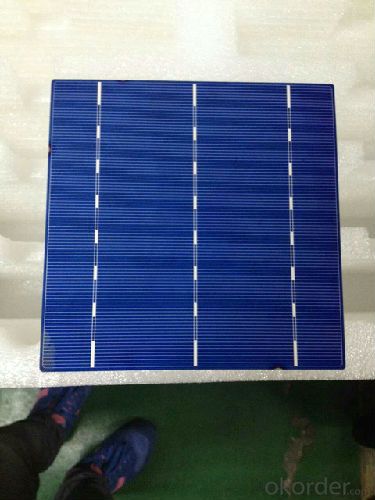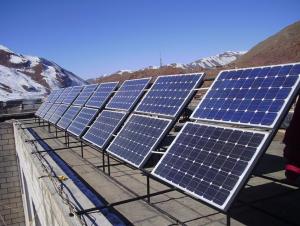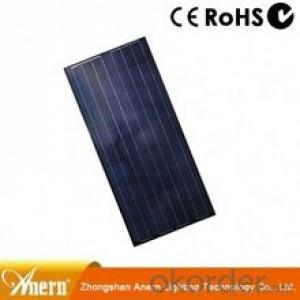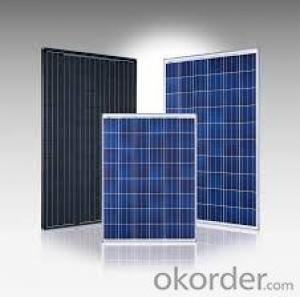Monocrystalline Silicon Solar Cell solar panel Good Quality and Price
- Loading Port:
- China Main Port
- Payment Terms:
- TT or LC
- Min Order Qty:
- -
- Supply Capability:
- -
OKorder Service Pledge
OKorder Financial Service
You Might Also Like
Quick Details
| Material: | Monocrystalline Silicon | Character: | solar panel price | Silicon: | Grade A class |
| EVA: | Material | ||||
Packaging & Delivery
| Packaging Detail: | carton package |
| Delivery Detail: | 20days |

Specifications
monocrystalline solar panel
1.Good quality silicon cell
2.monocrystalline silicon
3.solar module with 2.27 current .5kg
Mono-crystalline silicon cells are the most efficient but also the most expensive type of solar panel. Made from single crystals of silicon, these cells capture 15% of the solar energy that shines on it.
Poly- or multi-crystalline silicon cells are made from silicon cut into very thin strips. They are less efficient than mono-crystalline cells, but are also slightly cheaper to buy.

- Q:What is the impact of dust and dirt on solar cell efficiency?
- Dust and dirt can significantly reduce the efficiency of solar cells. When dust and dirt particles accumulate on the surface of solar panels, they block sunlight from reaching the photovoltaic cells, thereby reducing the amount of electricity generated. This buildup can cause a decrease in energy production by up to 20%. Regular cleaning and maintenance of solar panels are crucial to ensure optimal efficiency and maximize the electricity output of the system.
- Q:What is the payback period for solar cells?
- The payback period for solar cells depends on various factors such as the initial cost of installation, the amount of electricity generated, and the cost of traditional energy sources in the area. On average, solar cells have a payback period ranging from 5 to 10 years, but in some cases, it can be as short as 3 years or as long as 20 years.
- Q:Can solar cells be used in military vehicles?
- Yes, solar cells can be used in military vehicles. They can provide an alternative source of energy to power various systems and equipment, reducing reliance on traditional fuel sources and enabling greater operational flexibility and sustainability. Additionally, solar cells can help extend the range and endurance of military vehicles in remote or austere environments where access to conventional fuel supplies may be limited.
- Q:Can solar cells be installed on vehicles?
- Yes, solar cells can be installed on vehicles. In fact, many electric and hybrid vehicles are equipped with solar panels on their roofs or hoods to harness solar energy and supplement their power source. These solar cells help to charge the vehicle's battery and increase its overall efficiency, reducing the reliance on traditional charging methods and improving sustainability.
- Q:Can solar cells be used in agricultural applications?
- Yes, solar cells can be used in agricultural applications. Solar panels can provide a renewable source of energy to power various agricultural processes such as irrigation systems, lighting, and ventilation in greenhouses, as well as powering electric fences and monitoring equipment in farms. Solar energy can help reduce reliance on fossil fuels and provide a sustainable and environmentally friendly solution for powering agricultural operations.
- Q:How do solar cells impact wildlife?
- Solar cells have a minimal impact on wildlife compared to other forms of energy generation. While the installation and maintenance of solar panels can disrupt local habitats temporarily, once operational, solar cells do not produce air or water pollution, noise, or hazardous waste that could harm wildlife. Additionally, solar farms can provide valuable habitats for certain species, as the spaces between panels can be used for vegetation growth. Overall, solar cells are considered a much cleaner and safer energy option for wildlife compared to traditional fossil fuels.
- Q:What is the role of solar cells in powering water pumping systems?
- Solar cells play a crucial role in powering water pumping systems as they convert sunlight directly into electricity. This renewable energy source eliminates the need for traditional power sources and reduces the reliance on fossil fuels, making water pumping systems more environmentally friendly and sustainable. Additionally, solar cells provide a reliable and cost-effective solution, particularly in remote areas where access to electricity may be limited, ensuring that water can be pumped efficiently for various applications such as irrigation, agriculture, and domestic use.
- Q:Can solar cells be used in powering autonomous vehicles?
- Yes, solar cells can be used to power autonomous vehicles. Solar panels can be installed on the exterior or integrated into the body of the vehicle to capture sunlight and convert it into electricity. This renewable energy source can help supplement the vehicle's power needs, extending its range and reducing its reliance on fossil fuels. Additionally, advancements in solar technology and efficiency are making it more feasible to use solar power as a primary or secondary energy source for autonomous vehicles.
- Q:How about the solar cell 156mm Mono-Crystalline?
- It is difficult to explain, but the measurement usually doesn't matter, because only the materials matters most for the solar cells.
- Q:What is the impact of solar cell installations on property values?
- Solar cell installations generally have a positive impact on property values. Studies have shown that homes equipped with solar panels tend to sell for higher prices and at faster rates compared to homes without solar. The cost-saving benefits of solar energy, such as reduced electricity bills, attract potential buyers and increase the desirability of the property. Additionally, the environmental benefits associated with solar power contribute to the positive perception of the home, further boosting its value.
1. Manufacturer Overview |
|
|---|---|
| Location | |
| Year Established | |
| Annual Output Value | |
| Main Markets | |
| Company Certifications | |
2. Manufacturer Certificates |
|
|---|---|
| a) Certification Name | |
| Range | |
| Reference | |
| Validity Period | |
3. Manufacturer Capability |
|
|---|---|
| a)Trade Capacity | |
| Nearest Port | |
| Export Percentage | |
| No.of Employees in Trade Department | |
| Language Spoken: | |
| b)Factory Information | |
| Factory Size: | |
| No. of Production Lines | |
| Contract Manufacturing | |
| Product Price Range | |
Send your message to us
Monocrystalline Silicon Solar Cell solar panel Good Quality and Price
- Loading Port:
- China Main Port
- Payment Terms:
- TT or LC
- Min Order Qty:
- -
- Supply Capability:
- -
OKorder Service Pledge
OKorder Financial Service
Similar products
New products
Hot products
Hot Searches
Related keywords




























